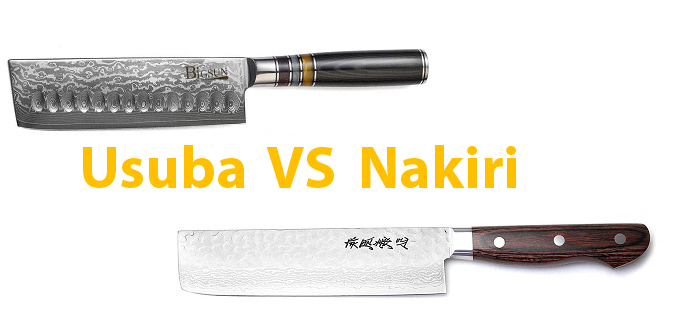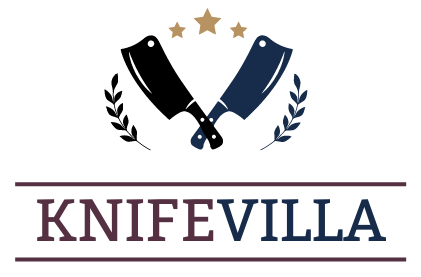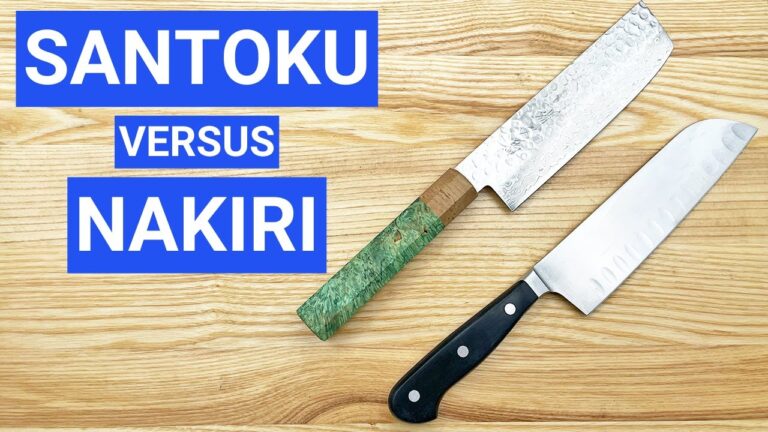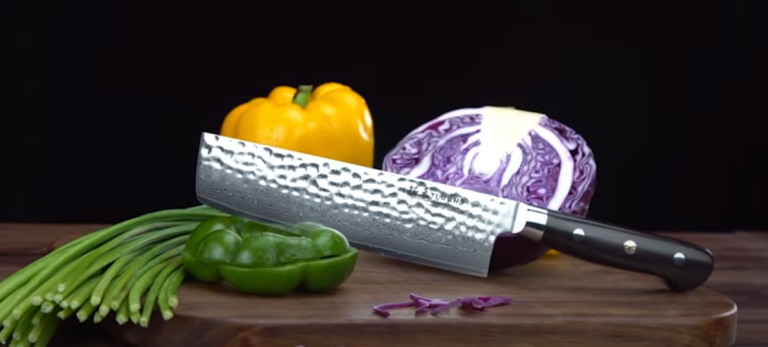Nakiri vs. Usuba: What is the difference?
A Nakiri knife and a Usuba knife are both traditional Japanese knives that are used for cutting vegetables. They are similar in many ways, but there are also some key differences between them.
| FEATURES | NAKIRI | USUBA |
|---|---|---|
| Hand use | Ambidextrous | One-sided |
| Bevel | Double | Single |
| Blade Edge | Strong | Delicate |
| Handle | Traditional Japanese | Traditional Japanese |
| Length | 6″-7″ Inches | 6″-9″ Inches |
| Blade shape | Flat tip | Flat or rounded tip |
| Cuts | Large as well as thin | Thin and decorative |
| Sharpening | Easy | Tough |
| Price | Low | High |
Nakiri VS Usuba
Similarities between Nakiri And Usuba:
There are also several similarities between them:
Blade Material: Both Nakiri and Usuba knives are typically made from high-carbon steel, which is known for its sharpness, durability, and ability to hold a fine edge. Some high-end models also use harder stainless steel alloy which is even more durable, but harder to sharpen.

Handle: Both have a wooden handle, which is typically made from magnolia wood or pakkawood. These handles are designed to provide a comfortable and secure grip, allowing for precision and control during cutting.
Grind: Both these knives have a razor-sharp edge, usually ground to around 7-12 degrees per side.
Weight and balance: Both are generally well-balanced, with a handle that is slightly heavier than the blade. This balance allows for easy control and maneuverability during cutting.
Use: They are designed for cutting vegetables, although Nakiri is more suited for chopping and slicing, and Usuba excels at peeling and shaping vegetables.
The origin: Both are traditional Japanese knives, using the traditional Japanese style in their design and construction, also following traditional techniques.
Aesthetics: They also share a traditional Japanese design aesthetic.
Both Nakiri and Usuba knives are specialized kitchen tools that are designed for cutting vegetables and share some similarities in their construction and design. But, their blade shape and single or double beveled edge, determine their specific use and performance in the kitchen.
Differences Between Nakiri And Usuba:
There are some key differences between them.
Blade shape: Nakiri knives have a rectangular blade shape with a straight edge that is sharpened on both sides, while Usuba knives have a thinner, flatter blade shape with a single bevel edge.

Cutting tasks: Nakiri knives are better suited for chopping and slicing vegetables, while Usuba knives excel at peeling and shaping vegetables.
Blade Thickness: Nakiri tend to have a thicker blade than Usuba, This means Nakiri knives are more sturdy and can handle more force when chopping, while Usuba knives are thinner and more delicate, making them better suited for precision tasks
Single bevel: Usuba knives have a single bevel edge which is sharpened on one side only, This allows for the creation of detailed cuts, such as juliennes or brunoise, but it’s harder to sharpen, and it’s not as easy to use for left-handed people
Size: Usuba knives are available in a range of sizes, from small to large, with the most common sizes being 180mm and 210mm, while Nakiri knives are available in a range of sizes, from small to large, with the most common sizes being 165mm and 180mm.
The main differences between Nakiri and Usuba knives are the blade shape and their intended use, with Nakiri knives being better suited for chopping and slicing, while Usuba knives excel at precision cutting and peeling. The Usuba knife has also a single bevel edge that can be harder to use, but also it’s more versatile and makes it easier to create detailed cuts.
Detailed Features of Nakiri Knife
The Nakiri knife is characterized by its rectangular blade shape, with a straight edge that is sharpened on both sides. This design allows for easy and precise cutting of vegetables. It is especially well-suited for tasks such as chopping and slicing. It is a traditional Japanese knife that is specifically designed for cutting vegetables. Here are some key features of it:
Blade shape: They have a rectangular blade shape with a straight edge that is sharpened on both sides.
Blade material: They are typically made from high-carbon steel, which is known for its sharpness, durability, and ability to hold a fine edge. Some high-end models also use harder stainless steel alloy which is even more durable, but harder to sharpen.
Handle: They typically have a wooden handle, which is typically made from magnolia wood or pakkawood. These handles are designed to provide a comfortable and secure grip, which provides precision and control during cutting.
Grind: Nakiri knives have a razor-sharp edge, usually grinded to around 7-12 degrees per side.
Size: They are available in a range of sizes, from small to large, with the most common sizes being 165mm and 180mm.
Weight and balance: They are generally well-balanced, with a handle that is slightly heavier than the blade. This balance allows for easy control and maneuverability during cutting.
If you want to buy a Nakiri Knife. Must read out Best Nakiri Knives Reviews
Detailed Features of Usuba Knife
The Usuba knife, on the other hand, has a thinner, flatter blade shape with a single bevel. Single bevel means it is sharpened on one side which makes it ideal for precise, delicate cutting tasks such as peeling and shaping vegetables. The Usuba also generally have a harder edge than the Nakiri.
Here are some of the key features of Usuba knives:
Blade shape: They have a thin, flat blade shape with a straight edge and a single bevel. The single bevel edge makes it ideal for peeling and shaping vegetables. The flat shape allows for easy rocking motion.
Blade material: They are made from high-carbon steel, which is known for its sharpness, durability, and ability to hold a fine edge. Some high-end models also use harder stainless steel alloy which is even more durable, but harder to sharpen.
Handle: They have a wooden handle, which is typically made from magnolia wood or pakkawood.
Grind: Usuba knives have a razor-sharp edge, usually grinded to around 7-12 degrees per side.
Size: These knives are available in a range of sizes, from small to large, with the most common sizes being 180mm and 210mm.
Weight and balance: Usuba knives are generally well-balanced, with a handle that is slightly heavier than the blade. This balance allows for easy control and maneuverability during cutting.
In short, both knives are great for vegetable prep, but the Nakiri is better suited for chopping and slicing while the Usuba excels at peeling and shaping vegetables, making it a choice for professional chefs and more experienced home cooks.
Nakiri and Usuba Uses
Nakiri Knife Uses:
Nakiri knives are specifically designed for cutting vegetables. They are particularly well-suited for tasks such as:
- Chopping: The straight edge of these knives allows for easy chopping of vegetables, making them a great tool for preparing ingredients for stir-fries, soups, and salads.
- Slicing: The sharpness of the knife allows for precise and clean slicing of vegetables, which is perfect for making uniform slices for dishes like tempura or sashimi.
- Mincing: The flat shape of the blade also allows for a rocking motion, making it good for mincing garlic and ginger.
- Dicing: The straight edge and sharpness allow for easy dicing of vegetables for dishes like ratatouille or salad.
- Peeling: The sharpness of the knife allows for the easy peeling of vegetables such as carrots and cucumbers.
- Scraping: They are also used for scraping off any excess from a vegetable or fruit, particularly useful for cleaning fruits like apples and pears.
If you are still confused, about whether you should buy it or not, this post will make your decision easier.
Usuba Knife Uses:
Usuba knives are particularly well-suited for tasks such as:
- Peeling and Shaping: They are used for peeling vegetables like cucumbers and eggplants and shaping vegetables like carrots and daikon radishes.
- Creating decorative cuts: The precision of the Usuba knife allows for creating decorative cuts, such as julienne, brunoise, and many more.
- Sashimi and Sushi Preparation: They are traditionally used by professional chefs in Japan to prepare fish and seafood for sushi and sashimi.
- Deveining shrimp or fish: Due to its sharpness, Usuba can be used to devein shrimp and fish efficiently
- Scraping: The flat shape of the blade also allows for scraping the surface of vegetables.
Conclusion
Both the Nakiri and the Usuba are amazing and are used for slicing and cutting vegetables. The Nakiri knife is the best choice if you are a beginner. Nakiri knife is cost-effective and easy to control. While for vegetable decorations we recommend Usuba knives and they are expensive to some extent.


